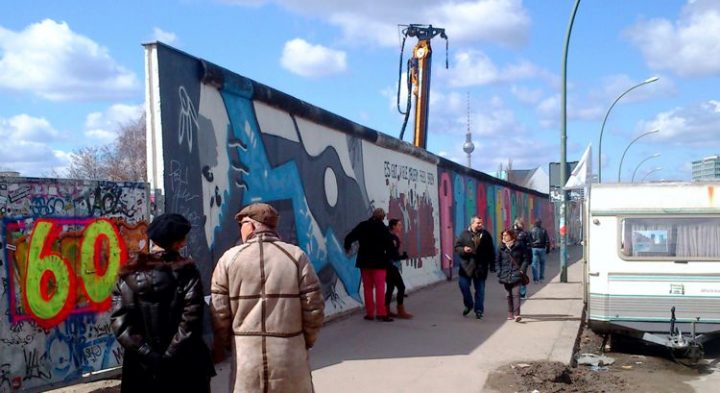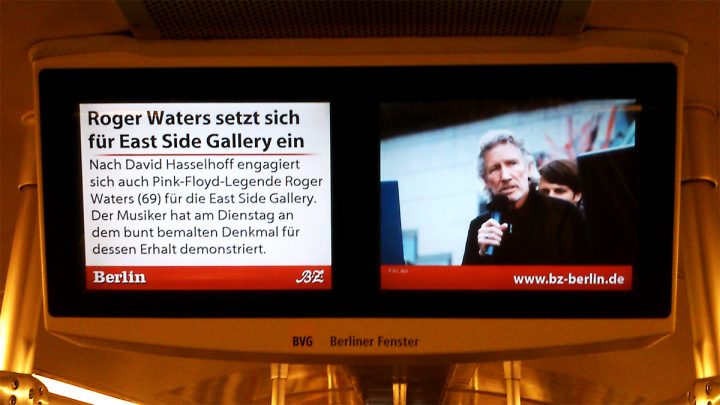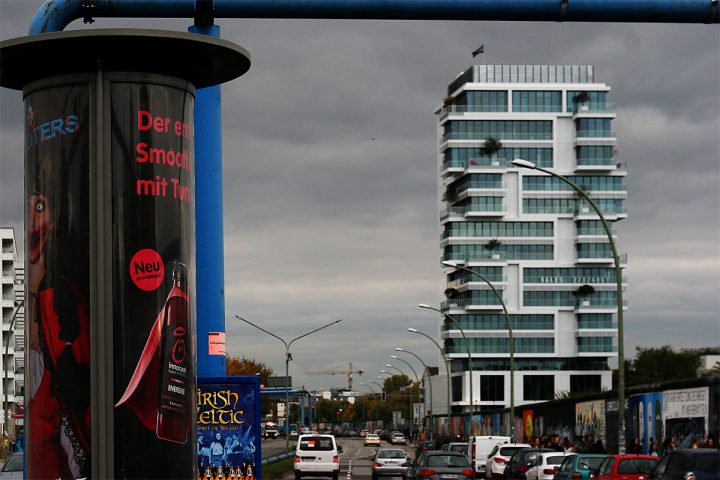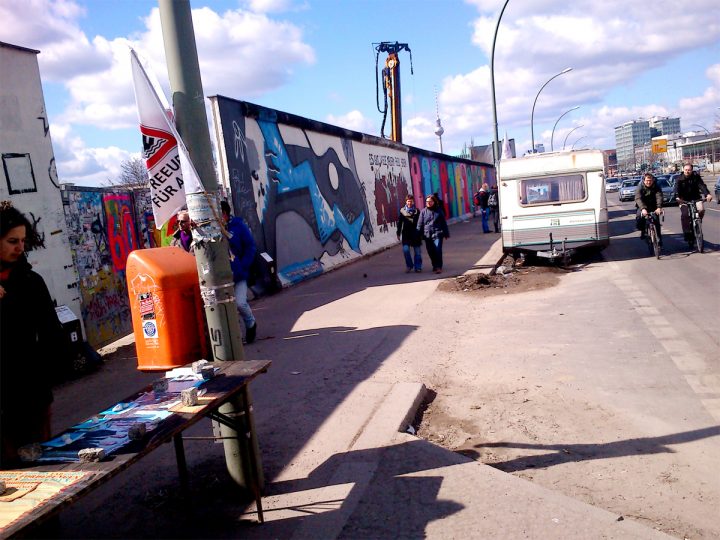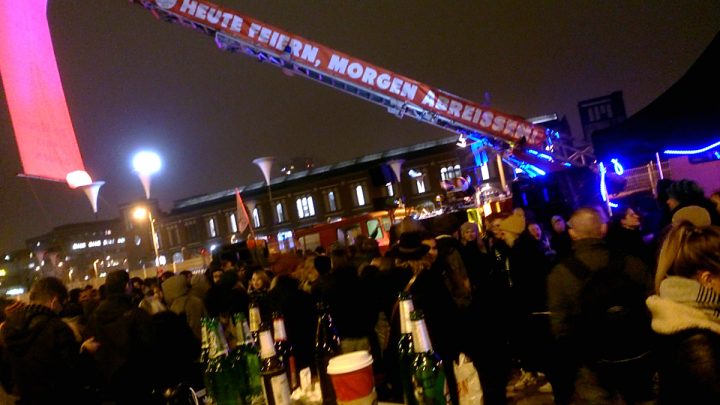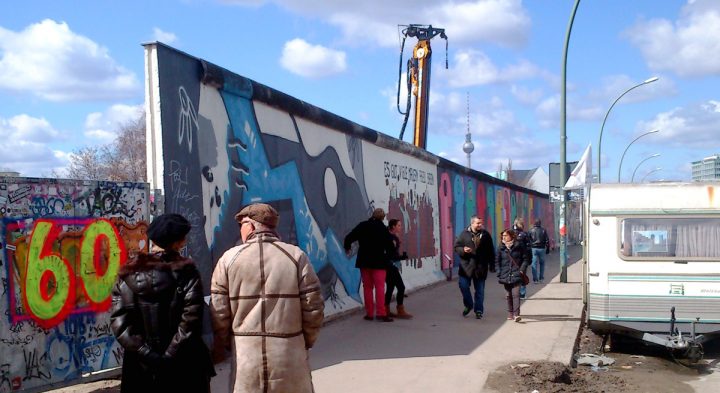Despite the fact that the East Side Gallery is a listed historic monument, it is deteriorating and becoming increasingly hemmed in. The main reason is that private interests are placed above public land rights and the law. People from all over the world, not just within Germany, are committed to the preservation of the longest remaining stretch of the Berlin Wall, which was painted by 118 artists from 21 different countries in 1990.
Christine MacLean, manager of the East Side Gallery during its creation, together with Jordi Pérez and Thomas Rojahn have more than rescuing it in mind. The East Side Gallery should be a living Monument to Joy. In a restaurant in the Kreuzberg neighbourhood, the three of them explain their plans and motives.
Jordi Pérez: As an initiative of the Alliance Save the East Side Gallery (Bündnis East Side Gallery retten!) we are against the commercial development of the land and want to preserve the area. We had an information caravan there for a few months. We often talked about what it is that captivates us and what the Wall means to us. The conversation often came round to the novel “Geteilter Himmel” (Divided Sky) by Christa Wolf whose title was rather a platitude for me, until I reached a place that gave me the impression that the old Berlin Wall was still closed. At that particular point, neither the beginning nor the end of the gallery was visible, then I looked up and it clicked. Suddenly I could see the divided sky. I saw the blue sky and this crass Wall. That’s why an unobstructed view is so important to us. Right there, where I had that experience, there is now a high-rise building. That experience is no longer possible.
Christine MacLean: When a part of the East Side Gallery was torn down in 2013 the international response was huge. Voice of America was on site before a single word was uttered by the German press. In the following months, as the conflict around the Wall continued, television crews came from Korea, China and Finland, as well as naturally from the USA and the UK. As a foreigner, it is incomprehensible to me how a section from a listed historic monument can simply be removed. The Berlin Senate simply doesn’t appreciate the significance of this monument. The huge importance of The East Side Gallery is better appreciated outside Germany. In addition, the law which applies to this monument has literally been broken. It is actually forbidden to build near it but the Berlin Senate acts as if it has some discretionary leeway.

Thomas Rojahn, Christine Mclean and Jordi Pérez
Jordi: The painting of the east side of the Berlin Wall between Ostbahnhof and the Oberbaumbrücke in 1990 was officially approved by the GDR’s Council of Ministers. Ironically, the Eastern municipal authorities are to be thanked for the fact that the East Side Gallery still exists today. The development of the former death strip violates the Berlin Monument Protection Law (§10 Heritage Protection Law Berlin). As the East Side Gallery is a border, it needs to remain so. New construction is not allowed when it affects the area surrounding the memorial.
How is the East Side Gallery different from the other memorials in Berlin and from the Berlin Wall Museum?
Jordi: The East Side Gallery is not a component of a negative memorial culture, as is often found in Berlin. It’s not about the documentation of horror, it’s a symbol of hope and joy.
Christine: The artists who painted the Wall in 1990 weren’t necessarily famous and many came from the East. Before, nobody could spit on the Wall on the east side, let alone paint it. The pictures are predominantly about peace, tolerance and love.
Jordi: They are the dreams, hopes and fears, which prevailed in 1989 as the Wall fell in the East and West. Above all, there was an optimistic mood that the Cold War was over and that the world had been given a new opportunity. This mood has manifested itself through the artists in their pictures and can still be felt today.
In the period afterwards many things occurred which have been forgotten. Starting with the peace and environmental movement, democracy in the GDR emerged. Even during the dictatorship round-table groups were formed and discussions with people in power began, almost on equal terms. It was a very progressive movement; the people were creative and artists could finally provide input. Different models of government were discussed and they worked on a draft constitution which was placed on record shortly before reunification.
It was this spirit of optimism and this feeling of freedom which was the moment of elation. When we look back today, people think primarily of reunification. Because of reunification, this new spirit of optimism was just lost in consumerism. As soon as they received their welcome money, the moment was gone or the people were no longer interested.
The end of the Cold War, which had the potential to become one of the greatest catastrophes in world history, simply became a peaceful reality overnight. The joy of it and the power which was then liberated at that time can still be felt today in Berlin. That is precisely this Berlin feeling, this freedom, which you have here in Berlin. These are still the late stages of that time, when suddenly there was an explosion of creativity. The East Side Gallery is a testimony to this momentous time. We should remember the power and the thoughts of that time and not simply focus on the 1990 reunification alone. We should recognize what occurred there exactly at that turning point and whether something can be found upon which to build a better world. This is the starting point of the Monument to Joy. The idea to call it that originated from Thomas.
Thomas Rojahn: I associate the joy that prevailed at that time and that strangers embraced on the street with the Ode to Joy, Beethoven’s 9th Symphony. You simply need to recall the images of the night in which the Berlin Wall fell. In this or a similar way, I imagine the moment that Schiller and Beethoven wanted to express. An utopian moment when people truly became like sisters and brothers.
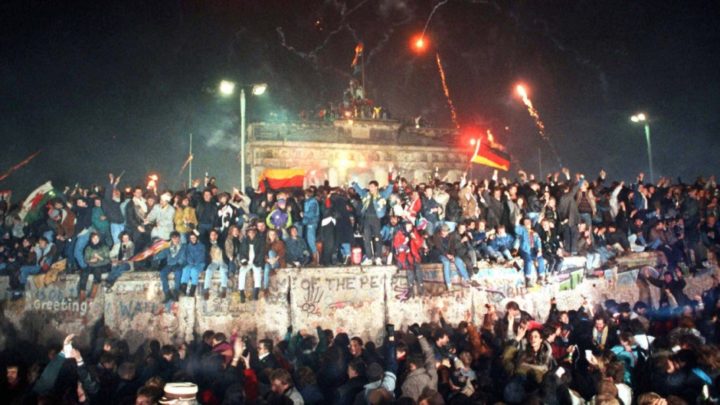
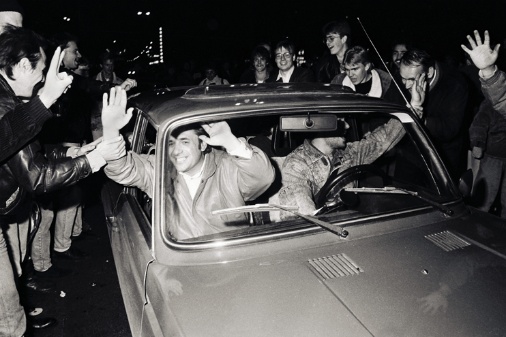
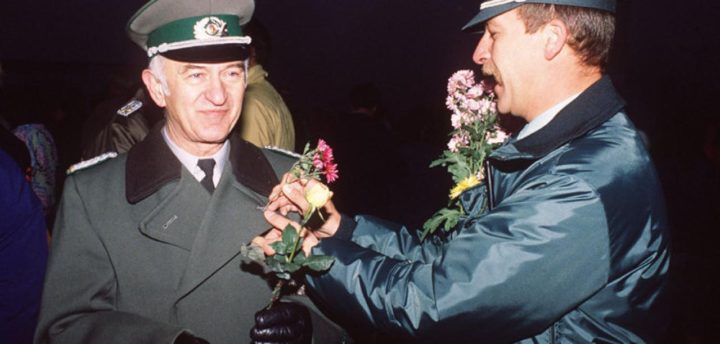
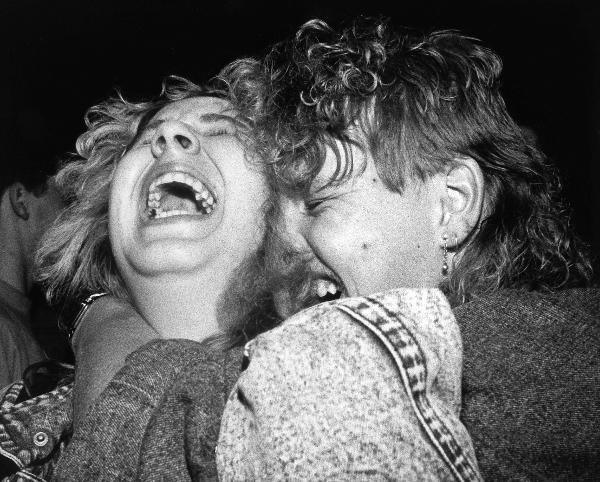
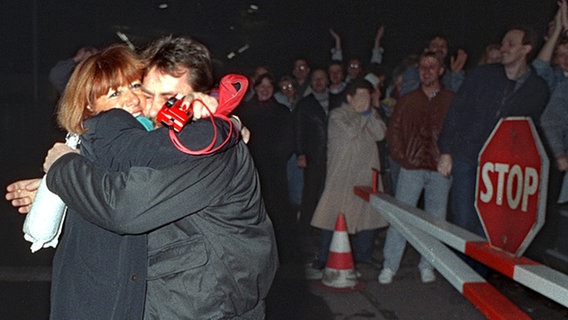
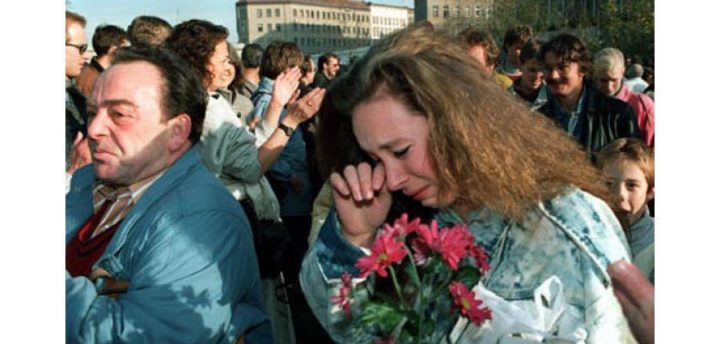
With Monument to Joy we are trying to reconnect to that time. The East Side Gallery is meant to remind you of this joy and that freedom is not given to you as a gift. To achieve this, we must discuss, reflect and become involved.
Jordi: A bit grandiose perhaps. At the time of the fall of the Wall, the wing of the daughter of Elysium touched the earth. The day was really joyful, because it did not really matter which class you belonged to or which fashion you followed. There was pure joy.
Thus the East Side Gallery could be understood as a manifest ode to joy. Joy becomes the connecting element of mankind and overcomes all apparent differences that separate us.
This utopia, conceived by Schiller and Beethoven, became a reality in that split second; it was only a wing beat. This was followed by consumerism and freedom was hijacked. This is why the gallery is needed as a symbol and a finger in the wound. A reminder that it is not about the day of reunification but about the fall of the Wall and the period preceding it. A reminder of the democratic-freedom-minded thinking that, mainly in the East, paved the way. We want to invite people to imagine themselves right there at that time, to be bold and to become involved.
Does there need to be a new “turning point”
Jordi: First of all, we need direction! People are deeply unsettled, there is a lot of negative energy about. It is important to have a symbol to provide a positive orientation for human rights, freedom and solidarity.
What we are experiencing at the moment in Europe, especially with refugee issues, is frightening. In particular, it is a horrible thing to see that a new wall (indirectly, financed by German contributions) is being built along the Turkish-Syrian border. We distance ourselves from the fact that in the Mediterranean people are drowning in their thousands and we are not able to see that the cause lies with us. We want to protect the wealth we have extracted from the world by means of an inhumane (or unethical) and unfair economic, banking and finance system. We do not want to create scenarios of terror, something the extreme right takes pleasure in but create a clear symbol for freedom and joy. That is why the East Side Gallery is so important.

There are no exact figures, but every year around 5 million people visit the East Side Gallery. There must be a reason for it. On the one hand people come because of the art, on the other hand, I am convinced that it is this sense of freedom that attracts people, even if they are perhaps not so aware of it.
Is this a reorientation of the original idea, Christine?
Christine: It’s a natural continuation. The Berlin Wall did not simply open, but the border was relaxed in stages. At the Oberbaum bridge, the people were queuing up to walk across the bridge, because with the prevailing traffic chaos it was often faster than driving. We, the organisers and artists who were working on the Wall at the time, overheard the conversations of the people on the street. We picked up on the prevailing energy and feelings and many artists’ works were influenced by this. As a natural medicine practitioner, I feel that the Wall has been transformed and healed by the work carried out on it and through the energy that everyone invested in it. Many people died because of this Wall but we transformed it.
What is the concept for the Monument to Joy?
Thomas: On the website of our initiative, “East Side Gallery – a monument to joy” you find food for thought. There is a reason that it is called food for thought and not a concept. We want an initiative from the bottom up and everyone should be able to have a say. It is not the intention to have some fancy concept presented from above. People should reflect on what they would like to see in this important place. The food for thought should simply provide inspiration points as to which direction this could go in.
Jordi: We especially like the idea of setting up a “Speaker’s Corner”. As a symbol of freedom, the Berlin Senate, like London, should pass a law so that everyone can talk freely.
Germany boasts about its freedom of opinion and the right of demonstration. In fact, one quickly sees that the reality is different. I’ve been picked up by the state security services because I’ve spent the whole day handing out flyers at the East Side Gallery.
You are also not allowed to spontaneously hold up a banner in Germany, if you do, it will be confiscated by the police. That’s why a speaker’s corner is needed to show that not everything is as good as it seems.
Thomas: We would really like to invite artists along to events. There is still a lot of space behind the East Side Gallery which could be used for temporary art installations. Graffiti and street art belong to the Wall and by setting up boards or canvases for this purpose, a legally approved space for the expression of this kind of art could be created. That is just one example. In addition, if the existing infrastructure in the vicinity (such as the Radial System culture centre) was used for conventions, conferences and concerts around this theme then the East Side Gallery could become an even greater attraction.
It is important that the East Side Gallery doesn’t turn into a museum piece but is rather a living memorial to joy on which people will always have the opportunity to work.
Jordi: There is a huge risk that things will develop in another, less desirable direction. We now have three museums in the area which also call themselves East Side Museum or something similar. We just need to be very careful that the allure of the East Side Gallery is not abused and exploited for commercial gain. That is the biggest fear I have.
What does it take to realize this idea?
Christine: We want to mobilize people from outside, for example with an international campaign.
Thank you very much for the fascinating conversation!
Translation from German by skelly14 from Trommons, proofreading by Elena Blank from Trommons and Christine Mclean
